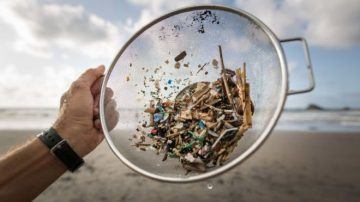Helen Briggs in BBC:
 Daniella Hodgson is digging a hole in the sand on a windswept beach as seabirds wheel overhead. “Found one,” she cries, flinging down her spade. She opens her hand to reveal a wriggling lugworm. Plucked from its underground burrow, this humble creature is not unlike the proverbial canary in a coal mine. A sentinel for plastic, the worm will ingest any particles of plastic it comes across while swallowing sand, which can then pass up the food chain to birds and fish. “We want to see how much plastic the island is potentially getting on its shores – so what is in the sediments there – and what the animals are eating,” says Ms Hodgson, a postgraduate researcher at Royal Holloway, University of London. “If you’re exposed to more plastics are you going to be eating more plastics? What types of plastics, what shapes, colours, sizes? And then we can use that kind of information to inform experiments to look at the impacts of ingesting those plastics on different animals.”
Daniella Hodgson is digging a hole in the sand on a windswept beach as seabirds wheel overhead. “Found one,” she cries, flinging down her spade. She opens her hand to reveal a wriggling lugworm. Plucked from its underground burrow, this humble creature is not unlike the proverbial canary in a coal mine. A sentinel for plastic, the worm will ingest any particles of plastic it comes across while swallowing sand, which can then pass up the food chain to birds and fish. “We want to see how much plastic the island is potentially getting on its shores – so what is in the sediments there – and what the animals are eating,” says Ms Hodgson, a postgraduate researcher at Royal Holloway, University of London. “If you’re exposed to more plastics are you going to be eating more plastics? What types of plastics, what shapes, colours, sizes? And then we can use that kind of information to inform experiments to look at the impacts of ingesting those plastics on different animals.”
Microplastics are generally referred to as plastic smaller than 5mm, or about the size of a sesame seed. There are many unanswered questions about the impact of these tiny bits of plastic, which come from larger plastic debris, cosmetics and clothes. What’s not in dispute is just how far microplastics have travelled around the planet in a matter of decades. “They’re absolutely everywhere,” says Hodgson, who is investigating how plastic is making its way into marine ecosystems. “Microplastics can be found in the sea, in freshwater environments in rivers and lakes, in the atmosphere, in food.”
More here.
